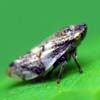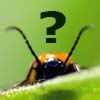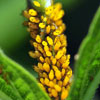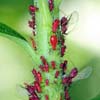Categories » Hoppers, Aphids,
Cicadas & Kin
Order: Hemiptera, suborder Auchenorrhyncha (Cicadas, leafhoppers,
sharpshooters, treehopper, panthoppers, spittlebugs and the like)
and suborder Sternorrhyncha (aphids, mealybugs, white flies,
scale insects and the like). Hemiptera is derived from the Greek
"hetero-" meaning different and "ptera" meaning wings, refers
to the fact that the texture of the front wings is different near
the base (leathery) than at the apex (membranous). Many of these
bugs secrete a sweet liquid waste called honeydew, the "manna
from heaven" of the Bible. Ants often tend these insects protecting
them from predators and parasites inexchange for the honeydew
like mini cattle ranchers.
For sub order Heteroptera ("original" true bugs including stink
bugs, squash bugs, water bugs and assassin bugs) which is also
under the order Hemiptera, click here.
Hoppers:
|
 Leafhoppers:
Leafhoppers:
Family Cicadellidae, distinguished by rows of spines on
shin. Can jump over 4ox its body length! Includes Sharpshooters.
|
 Planthoppers: Planthoppers:
Part of the superfamily Fulgoroidea. Less common than leafhoppers
with fewer spines on hind legs but funnier shaped heads.
|
 Spittlebugs Spittlebugs
Family Cercopidae, make those spit-like masses during nymph stage. Adults also called froghoppers
for their funny visages.
|
|
 Treehoppers: Treehoppers:
Family Membracidae, awesome mimics barely recognizeable
as animal let alone an insect, looking like thorns or plant
bumps.
|
 Nymphs: Nymphs:
These tiny titans are a particular favorite of mine, not
sure what most look like as an adult but nonetheless...just
look!
|
 ID Me! ID Me!
|
Aphids:
|
 Oleander Aphids Oleander Aphids
Commonly found on Milkweed, color indicated ewe, don't eat me.
|
_th.jpg) Pea Aphids Pea Aphids
One of the most studied insects as a pest. Found these on my pumpkin plants, so perhaps not ID'd properly, feel free to correct.
|
 Rosy Apple Aphids Rosy Apple Aphids
Oh dear, more pests, for orchard trees.
|
|
 ID ME!: A bunch of black ones, but a few green tossed in, in case I labeled them Pea Aphids by mistake. ID ME!: A bunch of black ones, but a few green tossed in, in case I labeled them Pea Aphids by mistake.
|
|
|
Cicadas:
|
 Exoskeletons: Exoskeletons:
I cannot believe I do not have a decent adult cicada photo
yet. Took a blurry one on my iphone one night, so not worthy.
|
|
|
*Excerpted from Kaufman Field Guide to Insects of
North America
|



